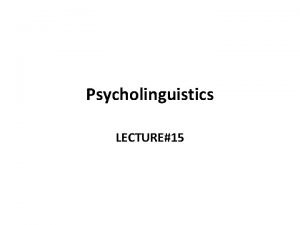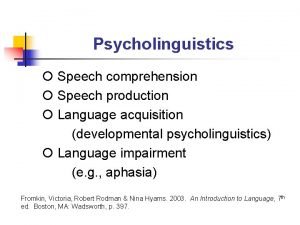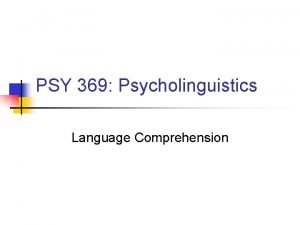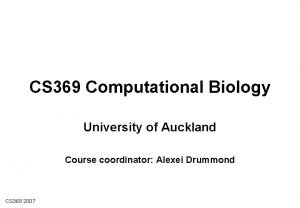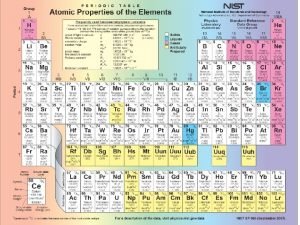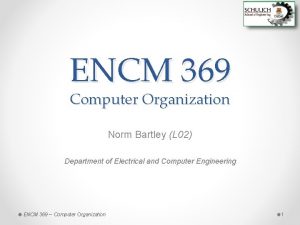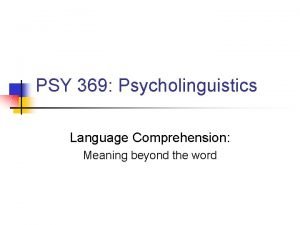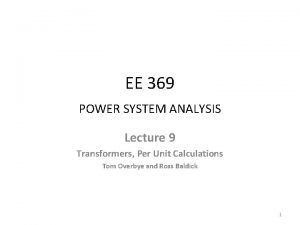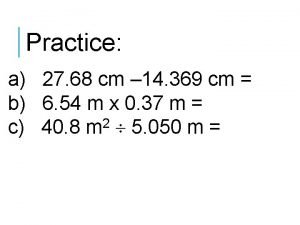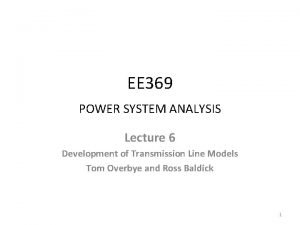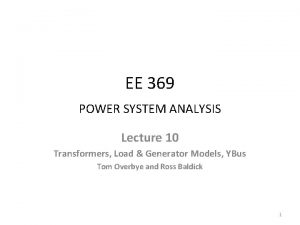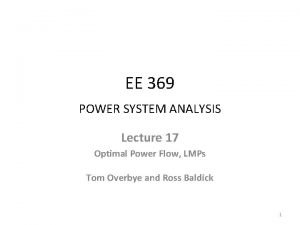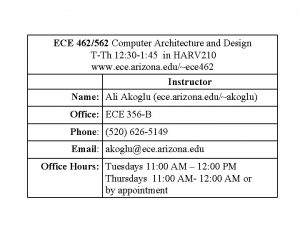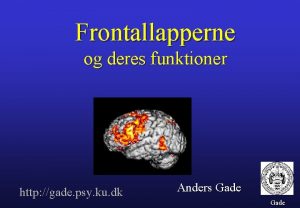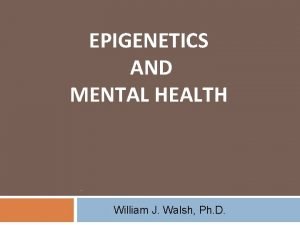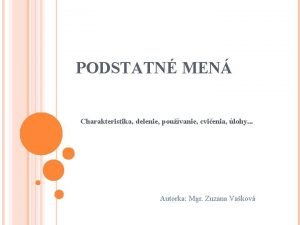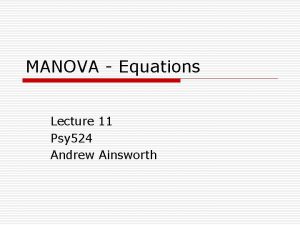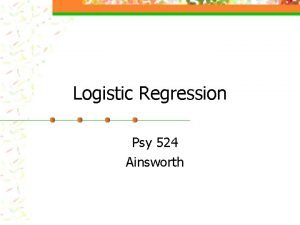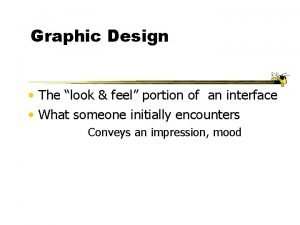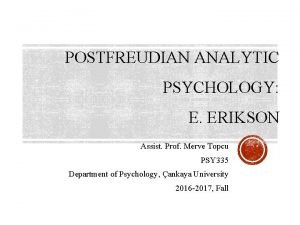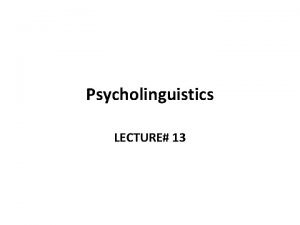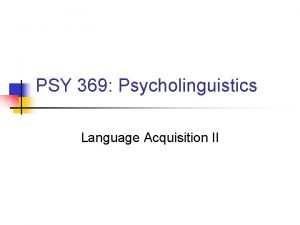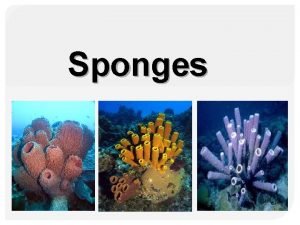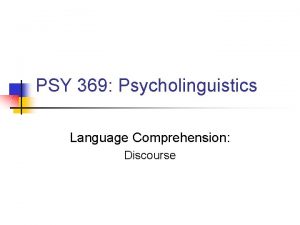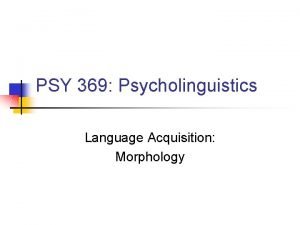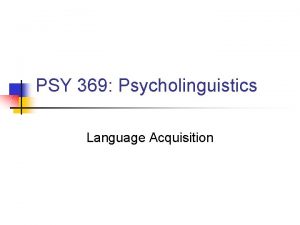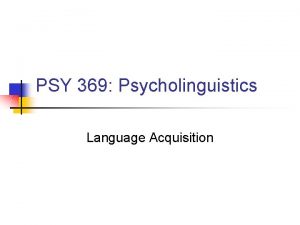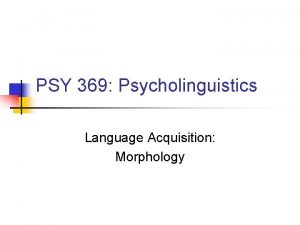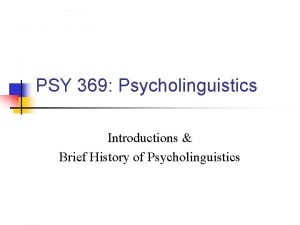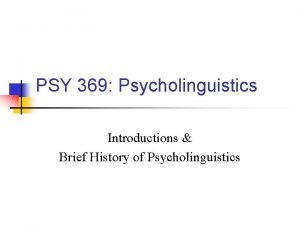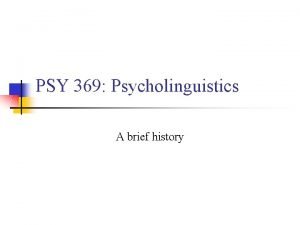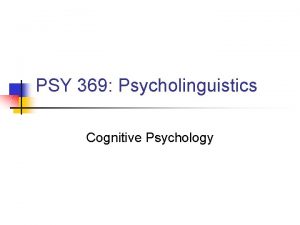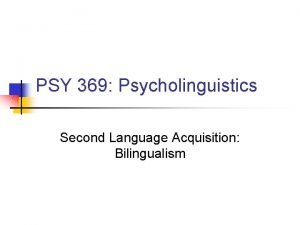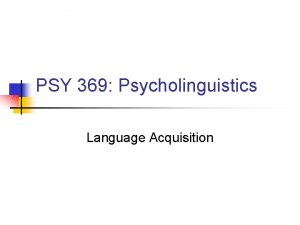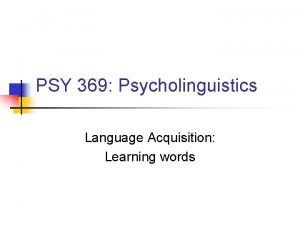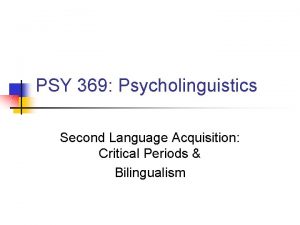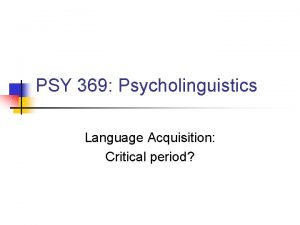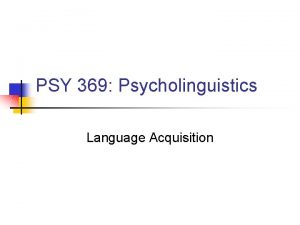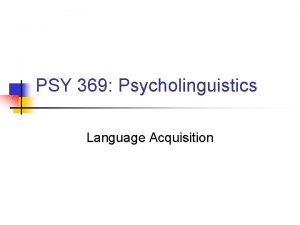PSY 369 Psycholinguistics Language Acquisition II Language Sponges








































- Slides: 40

PSY 369: Psycholinguistics Language Acquisition II

Language Sponges How do they do it (and what are they doing)? Learning words n 12 ms 2 yrs 3 yrs 6 yrs n n first words 200 words 1, 000 words 15, 000 words About 3, 000 new words per year, especially in the primary grades As many as 8 new words per day

Language Sponges n Learning words n n General patterns and observations Proposed Strategies n n n Fast mapping Whole object Mutual exclusivity Learning Syntax Learning Morphology

Early word learning n First words (Around 10 -15 months) n Emergence of systematic, repeated productions of phonologically consistent forms n Idiomorphs - personalized words n n Developed in systematic ways Not simply imitation, rather are creative Learned importance of consistency of names Typically context bound (relevant to the immediate environment) n n Important people, Objects that move, Objects that can be acted upon, Familiar actions Nouns typically appear before verbs

Semantic Development n Naming “Explosion” n 1 -general names n n 2 - specific names n n n “red” 5 -personal/social n n “mommy” 3 -action words 4 -modifiers n n “dog” “yes, no, please” 6 -functional n “what”

Semantic Development n Word Invention n n n n to broom (to sweep) to fire (to burn) to scale (to weigh) a fix-man (a mechanic) a tooth-guy (a dentist) a locker (a lock) bum wiper (bathroom tissue) yester-minute (a minute ago)

Semantic Development n Applying the words to referents n Extension n n Finding the appropriate limits of the meaning of words Underextension n n Applying a word too narrowly Overextension n Applying a word too broadly

Semantic Development n Later words: n Children come to use words in more adult-like ways n n Words start to be used in wider range of contexts Children use wider range of word types: n referential words (ball, doggie, chair) n proper names (Mummy, Spot) n actions (open, wash, tickle) n properties, states, qualities (more, gone, up, on, dirty) n social-pragmatic words (no, please) n few ‘frozen’ phrases (all gone, what’s that)

Extensions of meaning “tee”

Extensions of meaning “tee” 1: 9, 11

Extensions of meaning “tee” 1: 9, 11 1: 10, 18

Extensions of meaning “tee” 1: 9, 11 1: 10, 18 1: 11, 1 “googie”

Extensions of meaning “tee” 1: 9, 11 1: 10, 18 1: 11, 1 1: 11, 2 “googie”

Extensions of meaning “tee” 1: 9, 11 1: 10, 18 1: 11, 1 1: 11, 24 “googie”

Extensions of meaning “tee” 1: 9, 11 1: 10, 18 1: 11, 1 1: 11, 24 1: 11, 25 “googie” “tee/hosh”

Extensions of meaning “tee” 1: 9, 11 1: 10, 18 1: 11, 1 1: 11, 24 1: 11, 25 1: 11, 26 “googie” “tee/hosh” “hosh”

Extensions of meaning “tee” 1: 9, 11 1: 10, 18 1: 11, 1 1: 11, 24 1: 11, 25 1: 11, 26 1: 11, 27 “googie” “tee/hosh” “pushi”

Extensions of meaning “tee” 1: 9, 11 1: 10, 18 1: 11, 1 1: 11, 24 1: 11, 25 1: 11, 26 1: 11, 27 2: 0, 10 “googie” “tee/hosh” “moo-ka” “pushi” “hosh”

Extensions of meaning “tee” 1: 9, 11 1: 10, 18 1: 11, 1 1: 11, 24 1: 11, 25 1: 11, 26 1: 11, 27 2: 0, 10 2: 0, 20 “googie” “tee/hosh” “moo-ka” “pushi” “hosh” “biggie googie”

n One-word-per-referent heuristic Extensions of meaning n n If a new word comes in for a referent that is already named, replace it Exception to that was “horse, ” but it only lasted a day here “tee” 1: 9, 11 1: 10, 18 1: 11, 1 1: 11, 2 “googie” 1: 11, 24 1: 11, 25 1: 11, 26 1: 11, 27 2: 0, 10 2: 0, 20 “tee/hosh” “moo-ka” “pushi” “hosh” “biggie googie”

Strategies for learning n Expansion and contraction can occur at the same time “tee” 1: 9, 11 1: 10, 18 1: 11, 1 1: 11, 2 “googie” 1: 11, 24 1: 11, 25 1: 11, 26 1: 11, 27 2: 0, 10 2: 0, 20 “tee/hosh” “moo-ka” “pushi” “hosh” “biggie googie”

Strategies for learning Child tries different things, if a word doesn’t work then try something else n e. g. , hosh didn’t for the large dog, switched to biggie doggie n “tee” 1: 9, 11 1: 10, 18 1: 11, 1 1: 11, 2 “googie” 1: 11, 24 1: 11, 25 1: 11, 26 1: 11, 27 2: 0, 10 2: 0, 20 “tee/hosh” “moo-ka” “pushi” “hosh” “biggie googie”

Indeterminacy: Frog? Green? Ugly? Jumping?

Quine’s gavagai problem n The problem of reference: n n a word may refer to a number of referents (real world objects) a single object or event has many objects, parts and features that can be referred to Frog? Green? Ugly? Jumping?

Learning word meanings n Learning words n Fast mapping n Using the context to guess the meaning of a word Please give me the chromium tray. Not the blue one, the chromium one. n n All got the olive tray Several weeks later still had some of the meaning

Constraints on Word Learning n Markman (1989) n Perhaps children are biased to entertain certain hypotheses about word meanings over others n n These first guesses save them from logical ambiguity Get them started out on the right track n n n Object-scope (whole object) constraint Taxonomic constraint Mutual exclusivity constraint

Strategies for learning Object-scope (whole object) constraint n Words refer to whole objects rather than to parts of objects Dog

Strategies for learning Taxonomic constraint n n Words refer to categories of similar objects Taxonomies rather than thematically related obejcts ‘Here is a lux’ ‘Show me another lux’

Strategies for learning n n But in ‘no-word’ conditions, they would be shown the first picture See this? Can you find another one?

Strategies for learning

Strategies for learning Mutual exclusivity constraint (Markam and Watchel 1988) n n Each object has one label & different words refer to separate, non-overlapping categories of objects An object can have only one label ‘Show me a dax’: n they choose the corkscrew n because it is a less well known object for which they don’t have a label yet.

Problem with constraints n Most of the constraints proposed apply only to object names. n n There have been cases where children have been observed violating these constraints n n What about verbs? (Nelson 1988) Using for example the word ‘car’ only to refer to ‘cars moving on the street from a certain location’ (Bloom 1973) The mutual exclusivity constraint would prevent children from learning subordinate and superordinate information (animal < dog < poodle)

Language explosion continues n n The language explosion is not just the result of simple semantic development; the child is not just adding more words to his/her vocabulary. Child is mastering basic syntactic and morphological rules.

Language explosion continues n Proto-syntax (? ) n Holophrases n Single-word utterances used to express more than the meaning usually attributed to that single word by adults “dog” might refer to the dog is drinking water n n May reflect a developing sense of syntax, but not yet knowing how to use it Controversial claim (e. g. , see Bloom, 1973)

Language explosion continues n Syntax n Basic child grammar (Slobin, 1985) n n Similarities across all languages Mean length of utterance (MLU) in morphemes n Take 100 utterances and count the number of morphemes per utterance Daddy coming. Hi, car. Daddy car comed. Two car outside. It getting dark. Allgone outside. Bye-bye outside. # morphemes: 3, 2, 4, 3, 4, 2, 2 ‘-ing’ and ‘-ed’ separate morphemes ‘allgone’ treated as a single word MLU = morphemes/utterances = 20/7 = 2. 86

Language explosion continues

Language explosion continues n Syntax n Roger Brown proposed 5 stages n Stage 1: Telegraphic speech (MLU ~ 1. 75; around 24 months) n n n One and two word utterances Debate: learning semantic relations or syntactic (position rules) Children in telegraphic speech stage are said to leave out the ‘little words’ and inflections: n e. g. Mummy shoe NOT Mummy’s shoe n Two cat NOT two cats

Language explosion continues n Syntax n Roger Brown proposed 5 stages n More than two words n Stages 2 through 5 n Stage 2 (MLU ~2. 25) begin to modulate meaning using word order (syntax) n Later stages reflect generally more complex use of syntax (e. g. , questions, negatives)

How do kids learn the syntax? n Innateness account n Pinker (1984, 1989) n Semantic bootstrapping Child has innate knowledge of syntactic categories Child learns the and linking rules meanings of some content words Child constructs some semantic representations Child makes guesses of simple sentences about syntactic structure based on surface form and semantic meaning

How do kids learn the syntax? n “It is in the stimulus” accounts n Children do not need innate knowledge to learn grammar n Speech to children is not impoverished (Snow, 1977) n Children learn grammar by mapping semantic roles (agent, action, patient) onto grammatical categories (subject, verb, object) (e. g. Bates, 1979)
 Acquisition vs learning
Acquisition vs learning Language loss in psycholinguistics
Language loss in psycholinguistics Enraged cow injures farmer with ax
Enraged cow injures farmer with ax Puldow cross
Puldow cross Short division vs long division
Short division vs long division Cs 369
Cs 369 369
369 +multilin +369 motor management relay
+multilin +369 motor management relay Norm bartley
Norm bartley Beyond comprehension meaning
Beyond comprehension meaning 369 power
369 power Bio 369
Bio 369 369 project
369 project Tom overbye
Tom overbye 369 power
369 power Datapy.bar
Datapy.bar 369 power
369 power 68000
68000 Euro psy
Euro psy Psychology electives ucf
Psychology electives ucf Psy 2055
Psy 2055 Psy 2055
Psy 2055 Xxxxblue
Xxxxblue Psy
Psy Psy sanin
Psy sanin Psy
Psy Psy
Psy Psy
Psy Psy
Psy Psy 226
Psy 226 When sam listens to his girlfriend susan
When sam listens to his girlfriend susan Alla kulikova
Alla kulikova Nukleus caudatus
Nukleus caudatus Psy walsh
Psy walsh Opis mačky po anglicky
Opis mačky po anglicky Vzor gazdina
Vzor gazdina 11 psy
11 psy Regression psy
Regression psy Psy
Psy Psy 335 purdue
Psy 335 purdue What is the language in
What is the language in

